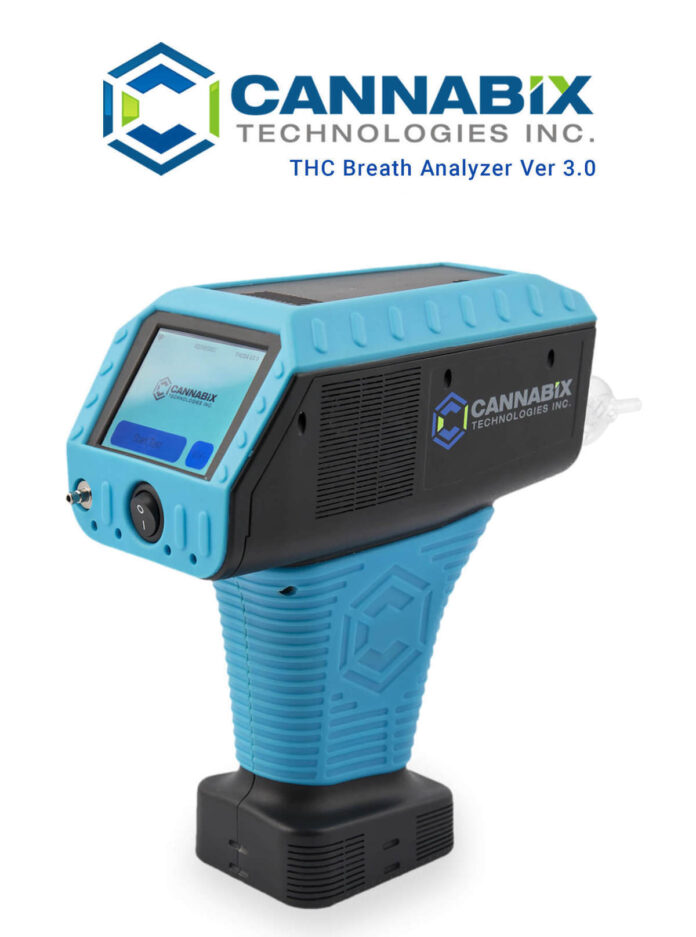VANCOUVER, British Columbia — Cannabix Technologies Inc. (CSE: BLO) (OTC PINK: BLOZF) (the “Company or Cannabix”) developer of marijuana breathalyzer devices for law enforcement and the workplace reports it continues to successfully test a supplemental version of its FAIMS technology for detection of ∆9-tetrahydrocannabinol (“THC”) and related analytes in human breath in new comprehensive multi-analysis study of subjects under the influence of marijuana in the southern United States (see July 12, 2022 news release). In the Southern US study, Cannabix is working alongside toxicologists and law enforcement officers who are testing subjects under the influence of marijuana. The Company’s technology (proprietary breath capture and marijuana detection equipment, described below) is being used side by side with several conventional drug screening methods (blood, oral fluid etc.). Further details of the study will be available in due course when disclosure approvals are granted to the Company.
In June and July, Cannabix participated in two testing day events held in two different US cities. Early study data is demonstrating very consistent correlation of levels of THC between breath samples collected and analyzed with Cannabix hardware and the current standard of whole blood. The Company’s updated handheld Breath Collection Unit (“BCU”, Fig. 1) and newly developed laboratory “MS Breath Sampler” (Fig. 2) were used together to provide a new ground-breaking method for drug detection that complements gold-standard mass spectrometry (MS), and significantly simplifies laboratory analysis methods, reduces sample turnaround time thus minimizing operating costs, while maintaining sensitive, precise results.
The Company has developed a unique breath capture system, capable of collecting low volatility analytes, such as THC, from approximately 5 breaths, which is the first time that such a capability for low volatility analytes has been developed. In addition, the Cannabix device captures analytes efficiently such that the sample preparation steps needed in traditional methods are completely eliminated. The system has detected and confirmed THC in breath out to 4 hours after smoking with breath samples being stored and analyzed up to two days after sample collection.
THC in Breath & Blood Data
Study results show that breath levels of THC over time are consistent between subjects and data is demonstrating consistent correlation of levels of THC between breath and whole blood in early time points after smoking.
The experimental studies reported here include 10 subjects (6 men, 4 women). Similar to Cannabix’s earlier experiments in Ontario (see press release from May 9th, 2022) breath samples were collected at baseline (a timepoint just before smoking cannabis) as well as two time points after smoking cannabis, out to 1 hour and 45 minutes. Blood samples were collected at baseline (n=4) and at one timepoint after smoking (between T7 and T30 min, n=10).
Breath samples were collected and analyzed using the same hardware and methods as in the previous experimental study in Ontario. Collection was done with the Cannabix BCU, and samples were analyzed using the Cannabix Mass Spectrometer (MS) Breath Sampler coupled to a Thermo TSQ Quantum Ultra MS running in tandem mode. THC and fragment ions were analyzed using Thermo Xcalibur software, and areas under the chromatogram curves (AUC) were determined using the software’s detection feature. Whole blood samples were collected using standardized collection kits by licensed phlebotomists recruited from a local hospital, and were analyzed at a local lab using LC/MS/MS, according to conventional standard operating procedures.
The resulting breath data from this study (see Fig. 3 below) follow the same trend that was seen with experimental data from Ontario study (Fig. 4). Breath and whole blood levels of THC were consistent and correlate well within the relatively short time window. Observed breath results further support literature (1) on trends in THC metabolism, similarly to the earlier results. In this study, the storage time between collection and analysis of the breath samples was up to 52 hours (compared to 40 hours in Ontario study).
This study further demonstrates that the Cannabix breath sampling and analysis tools function effectively in the field and provide quick and nonintrusive breath sample collection and ease of analysis with no sample preparation needed. In comparison, legacy breath and saliva testing procedures require several sample extraction and preparation steps prior to analysis, and analysis itself can take from 1 – 3 hours per sample. This is expensive and not amenable to high throughput operations. Also, legacy breath and saliva testing procedures have inefficient collection methods and recoveries are still often poor.
Blood is currently the standard of measurement for drug determination by law enforcement and toxicologists, and is used as objective evidence of possible impairment in courts of law. Cannabix’s simple and reliable breath collection and analysis method (thus far used in several small preliminary tests) shows very good correlation to blood, which is the standard method to detect and confirm acute cannabis use in the field.
The BCU is also being used in concert with the Cannabix FAIMS Detection Unit (FDU), which is being developed as a fully portable system capable of both breath collection and analyses in the field.
“Cannabix is seeking to work with provincial, state and federal agencies, toxicologists, crime labs and private industry to expand on these ground breaking methods of THC in breath collection and analysis,” stated CEO, Rav Mlait.
About Cannabix Technologies Inc.
Cannabix Technologies Inc. is a developer of marijuana breathalyzer technologies for law enforcement and the workplace. Cannabix is working to develop drug-screening devices that will detect THC – the psychoactive component of marijuana that causes impairment using breath samples. Breath testing for THC would allow employers and law enforcement to identify recent marijuana use that better aligns with impairment. Cannabix devices are in the advanced prototype and pre-clinical testing stage.












